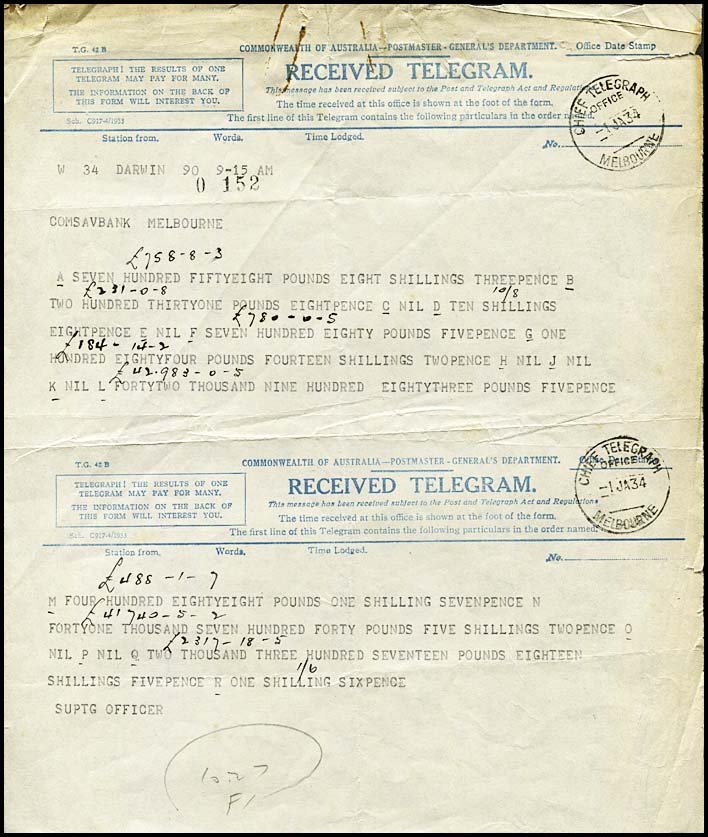Ordinary rate delivery form: AB-DO-7B.
- Home, index, site details
- Australia 1901-1988
-
New South Wales
- Overview of NSW
- Organisation
- Telegraph lines
- Telegraph Offices
- Date stamps
- Forms
- Envelopes
- Rates
- Stamps
-
Queensland
- Overview of Qld
- Telegraph lines
- Telegraph Offices
- Date stamps
- Forms
- Envelopes
- Rates
- Stamps
- Ephemera
-
South Australia
- Overview of SA
- Organisation
- Telegraph lines
- Telegraph offices
- Date stamps
- Forms
- Envelopes
- Rates
- Stamps
-
Tasmania
- Overview of Tasmania
- Organisation
- Telegraph lines
- Telegraph Offices
- Date stamps
- Forms
- Envelopes
- Railway lines
- Rates
- Stamps
-
Victoria
- Overview of Victoria
- Organisation
- Telegraph lines
- Telegraph Offices
- Date stamps
- Forms
- Envelopes
- Rates
- Stamps
- Ephemera
-
Western Australia
- Overview of WA
- Organisation
- Telegraph lines
- Telegraph offices
- Date stamps
- Forms
- Envelopes
- Rates
- Stamps
- International
- Special aspects
| Heading and notes: | Form number T.G. 42B. RECEIVED TELEGRAM below one line C of A heading and COMMONWEALTH is either short of the advertising box or just reaching it. |
| Message area: | Blank. |
| Reverse side: | Advertisements - 3 in 1933, 1 from 1934 to 1939. |
| Colours (text & form): | Blue on cream. |
| Size of form overall: | 126 × 214 mm. |
- all forms listed on this page have the form number T.G. 42B. Forms with number T.G. 42 are shown on another page;
- has an advertising box in top left corner. This advertised TELEGRAPH for four printings before changing to MONEY ORDER TELEGRAMS;
- schedule number is under the advertising box;
- entry under advertising box has been changed to "Office of Origin" from "Station From";
- a change from three to one advertisements on the reverse side in the second 1933 printing (DO-7Bc).
This change was accompanied by the introduction of the Hermes logo on the reverse side. There were a number of variations in its design.
These type 7B forms were printed from April 1933 whereas the (non-teletype) type 7 format with the same design were printed from June 1929.
The main distinctions amongst the varieties for the type 7B forms are:
| Format number |
Outline for box. | Advertisment at top left | Advertisement on reverse |
| 7Ba | Single line | Telegraph! ... in 4 full lines. | 3 adverts. |
| 7Bb | Double line | Telegraph! ... in 3 lines. | 3 adverts. |
| 7Bc | Double line | Telegraph! ... in 3 lines. | Single ad. with Hermes in shaded blue circle. |
| 7Bd | Single line | Telegraph! ... in 2 lines. | Single ad. with Hermes in unshaded blue circle. |
| 7Be | Double line | Money Order Telegram. | Single ad. with Hermes in blue oval. |
| 7Bf | Double line | Money Order Telegram. | Single ad. with Hermes in orange oval. |
| 7Bg | Single line | Money Order Telegram. | Single ad. with Hermes in orange oval. |
 Printed in November 1933. Printed in November 1933. |
AB-DO-7Bb.
Brisbane to Melbourne. Characteristics:
|
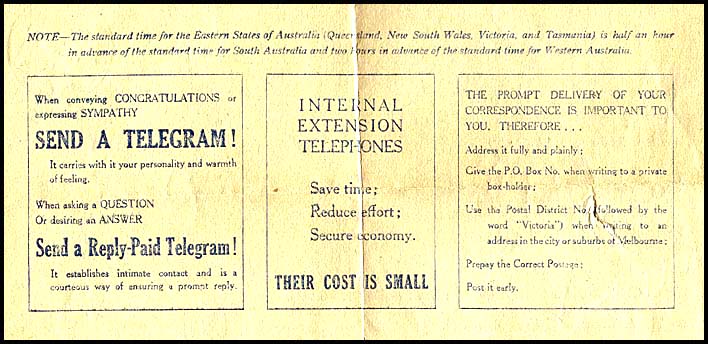 |
AB-DO-7Bb reverse.
The reverse side of the above form has three advertisements - all of which are separately boxed. The advertisements are for:
|
 Printed in November 1933. |
AB-DO-7Bc.
Adelaide to Richmond Characteristics:
|
 |
AB-DO-7Bc reverse.
Reverse side of the above delivery form. Characteristics:
|
 Printed in November 1934. |
AB-DO-7Bd.
Darwin to Melbourne Characteristics:
A double form with text in Commonwealth Bank code like that for AB-DO-7Ba (see Codes in Telegrams section). |
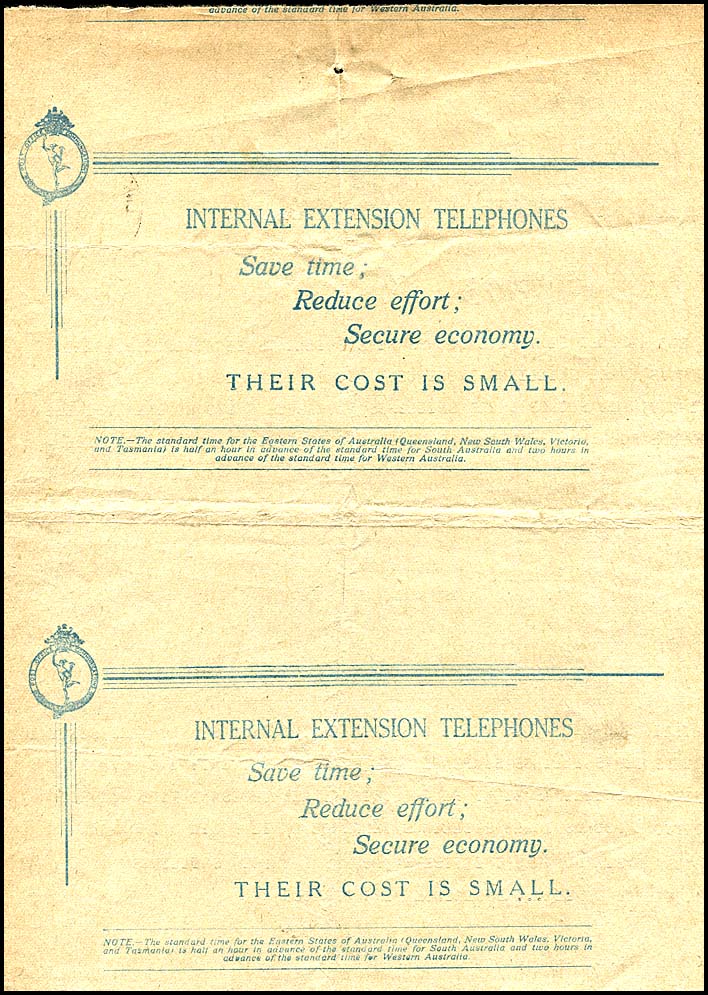 |
AB-DO-7Bd reverse.
Reverse side of the above form with a large single advertisement in blue. Hermes, in blue, is surrounded by a smaller circular frame than previously (diameter: 18 mm) and the background is unshaded. |
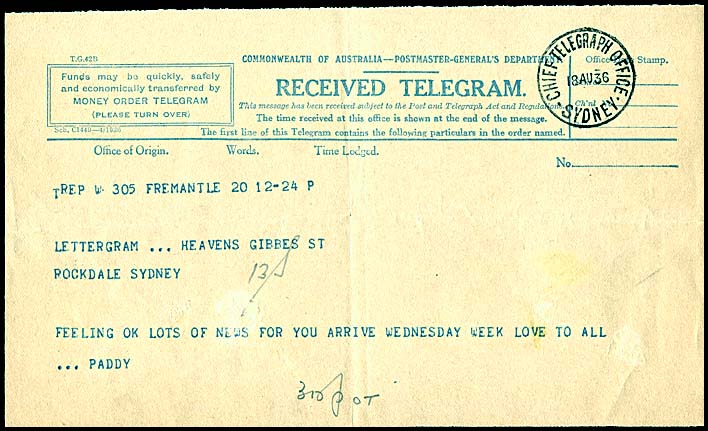 Printed in April 1936. |
AB-DO-7Be.
Fremantle to Sydney Characteristics:
|
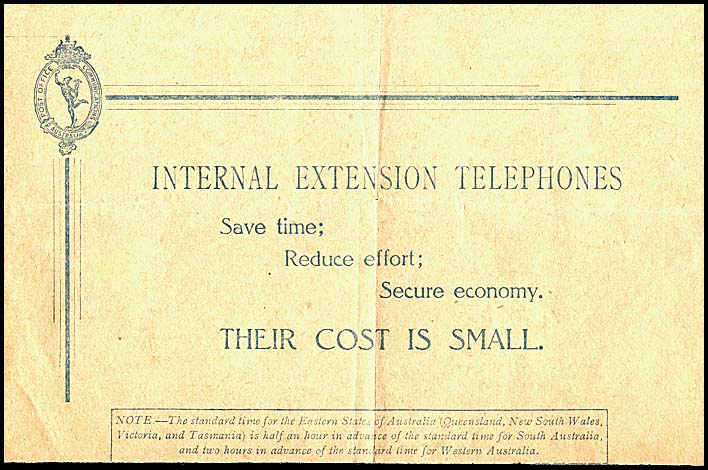 |
AB-DO-7Be reverse.
The single advertisement in blue on the reverse side of the above delivery form. The base of the form was slightly trimmed when the form was torn from the teletype machine. The Hermes image, in blue, is surrounded by an oval frame and an unshaded background. The image is leaning forward. It is 16 mm wide (at the waist) and 29 mm high.
|
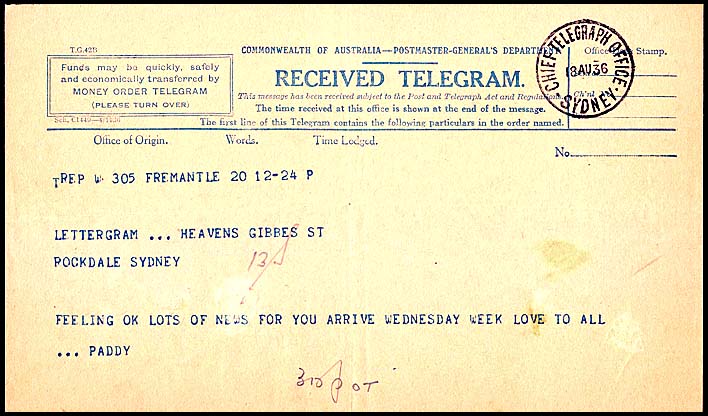 Printed in November 1937. |
AB-DO-7Bf.
Fremantle to Rockdale. Characteristics:
|
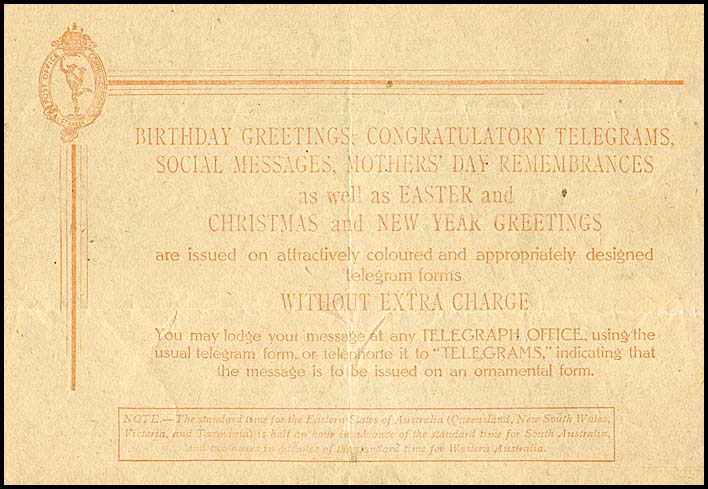 |
AB-DO-7Bf reverse.
The reverse side of the above form. Characteristics:
|
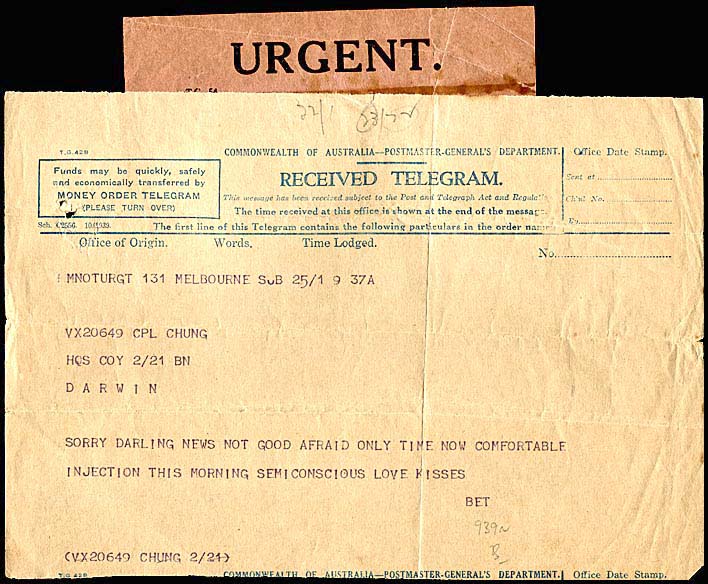 Printed in October 1939. |
AB-DO-7Bg.
Melbourne to Darwin Characteristics:
This particular form had been aligned incorrectly in the teleprinter and shows part of the following form at the base. Has a scarce 1935-42 URGENT label (123 mm) wide in orange. |
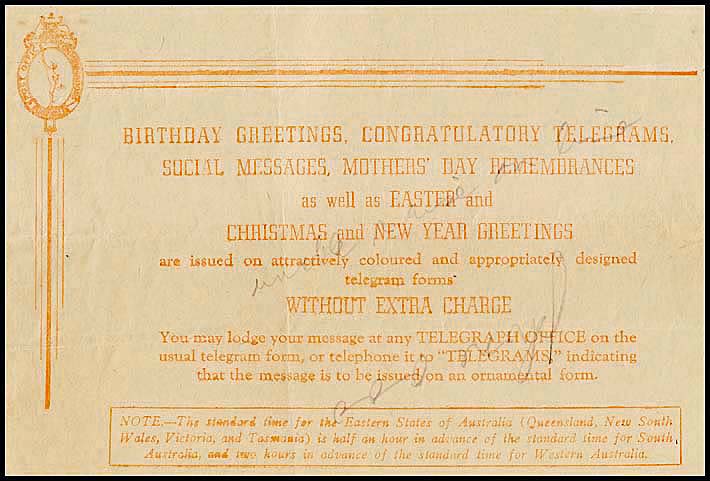 |
AB-DO-7Bg reverse.
Reverse side of the above form showing the one large advertisement in orange filling the back of the form. The Hermes image is 16.5 mm wide (at the waist) and 28 mm high. Advertisements known to be printed on the reverse side of this form are:
|
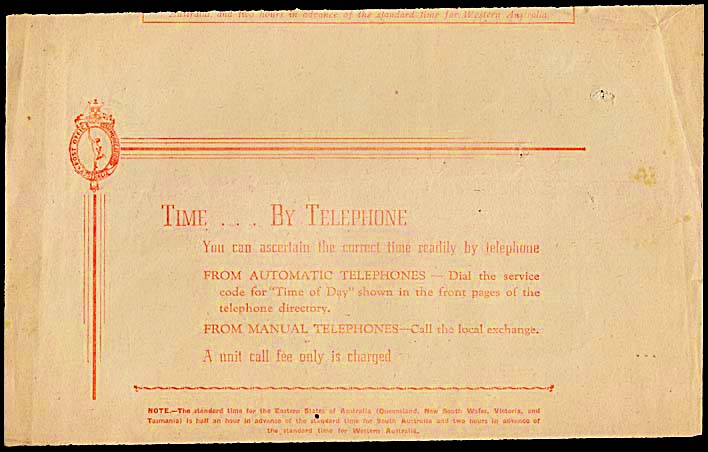 |
AB-DO-7g. The reverse side of a different DO-7Bh form. The TIME advertisement (# 1 in the above list) is shown. In the box below, which indicates time zones in Australia, the lowest line has five words finishing with Western Australia. The last line of the advertisement from the previous form is shown at the top. Clearly the format at the top is very different from that for TIME ... - but it is identical with that for Birthday Greetings shown above. Hence it appears that on the one teleprinter roll, different advertisements were printed. |
Details of use and rarity.
| Form sub-number |
Schedule number | Earliest recorded date | Rarity rating |
| DO-7Ba | Sch. C917- 4/1933 | 1 January 1934 at Chief Telegraph Office Melbourne. | NC |
| Sch. C917. 4/1933 | 4 April 1934 at Chief Telegraph Office Melbourne. | C | |
| Sch. C1013 - 8/1933 | 13 April 1934 at Chief Telegraph Office Melbourne. | C | |
| DO-7Bb | Sch. C1054. 11/1933 | 19 November 1934 at Chief Telegraph Office Melbourne. | C |
| DO-7Bc | Sch. C1054. 11/1933 | R | |
| DO-7Bd | Sch. C. 1237 - 11/1934 | 27 June 1935 at CTO Melbourne. | C (depending on the format of Hermes on reverse). |
| DO-7Be | Sch. C1449 - 4/1936 | 1 July 1936 at CTO Melbourne. | |
| DO-7Bf | Sch. C1958 - 11/1937 | 2 September 1938 at CTO Brisbane. | |
| DO-7Bg | Sch. 2233-11/1938. | 2 August 1940 at Darwin, N.T. | |
| Sch. C2556. 10/1939. | 13 May 1941 at CTO Melbourne. |
